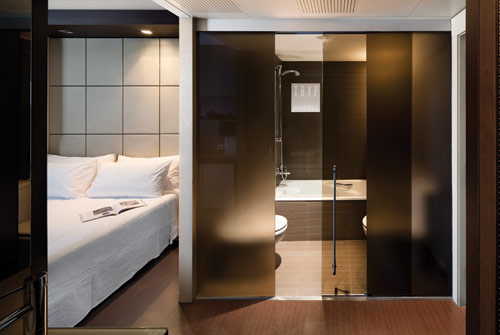Interior Sliding Frameless Glass Doors Make a Clear Contribution to LEED
Design Considerations
Glass walls and sliding doors may replace more traditional drywall or other less transparent and less flexible materials. In deciding to go with one material over another, architects may want to consider the advantages of interior glass.
Daylighting for Increased Productivity and Well-Being
Interior glass walls extend natural daylight deep into the space, and the sense of flow between interior spaces allows even more natural light and visual transparency. This daylight harvesting not only reduces the use of electricity, but increases occupant well-being and productivity—a claim supported by extensive research. In 1999, the Heschong Mahone Group published a seminal study Daylighting in Schools: An Investigation into the Relationship Between Daylighting and Human Performance. The study showed that students with the most daylighting in their classrooms progressed faster on math reading tests in one year than those with less daylighting. In 2003, the group completed a second suite of studies that found exposure to daylight positively impacted human performance in schools, stores, and offices. Among the study highlights: Office workers were found to perform 10 to 25 percent better on tests of mental function and memory recall when they had the best possible view versus those with no view. Furthermore, office worker self reports of better health conditions were strongly associated with better views. In one study, workers with the best views were the least likely to report negative health symptoms. Reports of increased fatigue were most strongly associated with a lack of view.
 |
Interior glass doors help increase the sense of light and space in hotel rooms. Photo courtesy of Klein USA, Inc. |
Companies, too, claim positive effects of daylighting on their workers. Pennsylvania Power & Light, for example, reported that after completing building upgrades to use more daylight, absenteeism rates dropped 25 percent, productivity increased 13.2 percent, and energy costs declined 69 percent. In another instance, Lockheed Martin maintains that after daylighting its facility in Sunnyvale, California, the company achieved 15 percent higher worker productivity.
Maximizing Space
It's a well known fact that glass walls expand a space visually. Frameless glass doors can give the impression of a taller, more spacious doorway than their framed counterparts, and the presence of expanses of glass in a room can alter the sense of scale, making even small rooms seem larger and more open. Hospitality designers faced with long, narrow hotel rooms are using glass partitions or glass sliding doors for closet and bathroom dividers to increase the sense of space and light—a tactic that is particularly effective for hotel bathrooms which are typically windowless. In addition, glass sliding doors retract, increasing the accessibility of a room, and because they are relatively thin and sleek, take up less space both visually and practically.
Consistent with Current Space Planning Trends
Gone—or going—are the red carpet areas with offices for senior managers. To many, the inner sanctum of private enclaves feels isolated and antithetical to collaboration with colleagues, a key driver of contemporary trends in space planning. For some years, the open office has been favored for reasons of better communication and a spirit of cooperation as well as more natural light and expansive outdoor views throughout the office. Promoting interconnectivity, the open plan provides the kind of interaction an office team needs, creating an ease of movement and workflow. Extensive intra and inter-departmental visual communication breaks down the psychological barriers between the different levels of function and assignments in a company.









